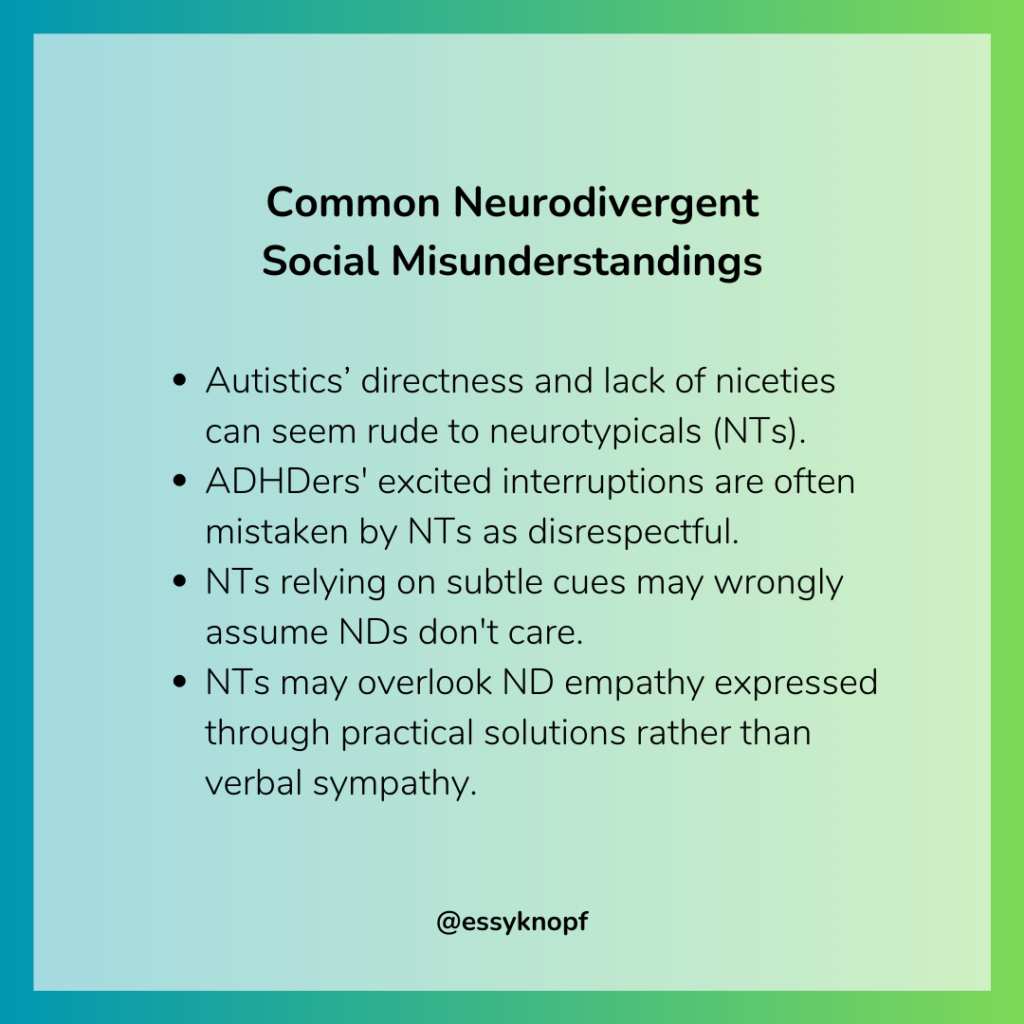The double empathy problem: Why autistic and ADHD communication isn’t the issue
Have you ever been told you “lack empathy” just because you communicate differently? Many autistics and ADHDers have, and it’s a frustrating and deeply unfair accusation. The assumption that neurodivergent (ND) people struggle with empathy stems from a widespread misunderstanding—one that the double empathy problem challenges head-on.
What Is the Double Empathy Problem?
Coined by autistic researcher Damian Milton, the double empathy problem suggests that communication difficulties between NDs and neurotypicals (NTs) aren’t solely due to a “deficit” in autistics or ADHDers. Instead, these difficulties arise from both sides struggling to understand each other due to their different ways of processing social information.
NTs often assume that their way of engaging in social interactions is the universal norm, leading them to misinterpret or dismiss ND communication styles. Autistics and ADHDers frequently experience the frustration of having their intentions misunderstood, their words misread, and their behaviors unfairly judged.
In other words, it’s not that NDs don’t experience empathy. It’s that NTs often fail to empathize with ND communication styles.
Why Neurotypicals Misinterpret Neurodivergent Communication
NTs tend to rely on unspoken social rules, body language, and subtext in their interactions. Autistics, on the other hand, often communicate more directly and literally, while ADHDers may struggle with impulse control, interrupting, or shifting topics quickly. These mismatches can create misunderstandings, such as:
- An autistic offering honest feedback and being perceived as “rude.” Many NTs expect social niceties and indirect communication, while autistics often value clarity and honesty.
- An ADHDer excitedly interrupting in conversation and being seen as “disrespectful.” ADHDers may struggle with impulse control, but their interruptions are usually a sign of engagement, not disregard.
- An NT expecting subtle emotional cues and assuming an ND doesn’t care when they don’t pick up on them. Autistics and ADHDers may express care in ways that differ from NT expectations, such as problem-solving instead of offering verbal reassurance.
- Autistics and ADHDers showing empathy in unique ways (like offering solutions rather than sympathy), which NTs might not recognize as empathetic. This can lead to the false perception that NDs lack compassion when in reality, they are trying to help in the way that makes the most sense to them.
Rather than acknowledging these differences, many NTs assume their way of communicating is “correct” and judge autistics and ADHDers unfairly. This one-sided perspective fuels harmful stereotypes, often leading to NDs being labeled as socially inept, inconsiderate, or even lacking in emotional depth.
The Emotional Toll on Neurodivergent People
Because NT society often places the burden of adaptation on NDs, many autistics and ADHDers end up masking their natural communication styles to avoid conflict. Masking—consciously or unconsciously imitating NT behaviors—can be exhausting, leading to stress, burnout, and even a loss of self-identity.
For example, autistics may force themselves to make eye contact, suppress stimming, or carefully script conversations. ADHDers may work to suppress their natural enthusiasm, monitor their speech patterns, or try to appear more “focused” in conversations.
This expectation that NDs must always adjust—without NTs making the same effort—reinforces systemic ableism. The result? Many NDs experience chronic anxiety in social settings, hesitant to engage for fear of being misunderstood or judged.

How Can We Bridge the Communication Gap?
Understanding and respecting different communication styles is the key to overcoming the double empathy problem. Here are a few steps both NTs and NDs can take:
- NTs: Recognize that direct communication isn’t “rude” and that ND expressions of empathy might look different from what you expect. Be open to different ways of connecting.
- NDs: Set boundaries around masking and self-advocate for your communication needs when possible. Explain your communication style when appropriate.
- Everyone: Practice mutual respect, ask for clarification instead of making assumptions, and acknowledge that different perspectives can enrich communication.
Final Thoughts
The double empathy problem reminds us that empathy is a two-way street. It’s time to challenge the outdated idea that autistics and ADHDers are the ones lacking in social understanding. True inclusion means recognizing that NT communication isn’t the default—it’s just one of many valid ways to connect.
By making space for different communication styles, we can move toward a more inclusive and accepting society—one where both NTs and NDs can engage with each other authentically, without fear of judgment.
How has the double empathy problem affected your experiences? Share your thoughts in the comments!

Essy Knopf is a therapist who likes to explore what it means to be neurodivergent and queer. Subscribe to get all new posts sent directly to your inbox.
© 2025 Ehsan "Essy" Knopf. Any views or opinions represented in this blog are personal and belong solely to the blog owner and do not represent those of people, institutions or organizations that the owner may or may not be associated with in professional or personal capacity, unless explicitly stated. All content found on the EssyKnopf.com website and affiliated social media accounts were created for informational purposes only and should not be treated as a substitute for the advice of qualified medical or mental health professionals. Always follow the advice of your designated provider.


